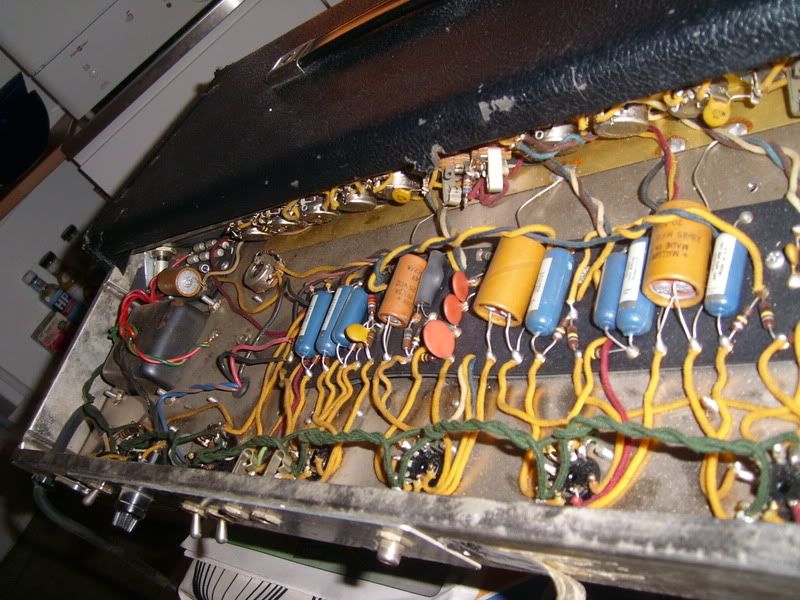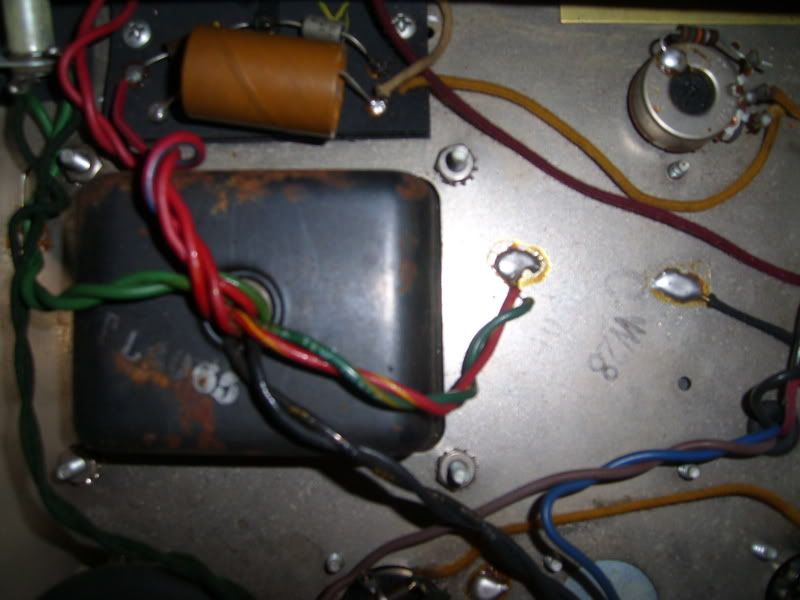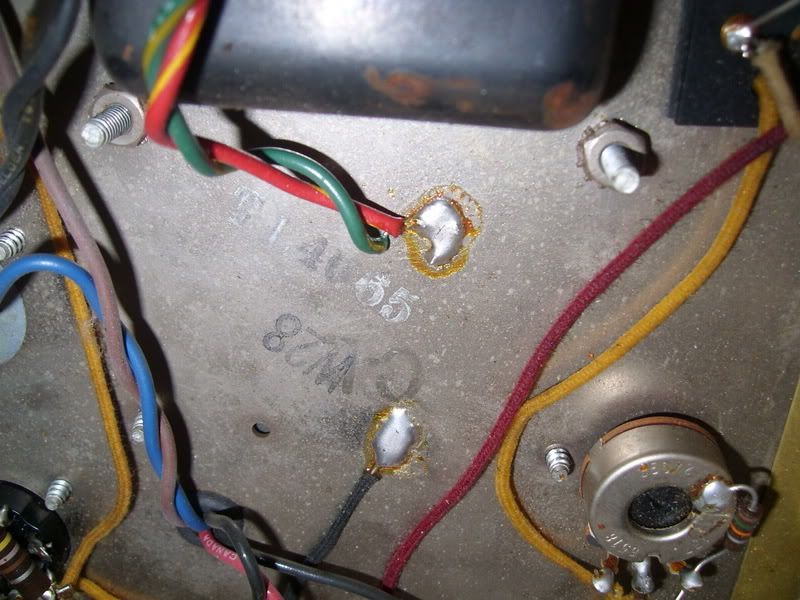you're right. The only thing worse than "cranky fender guy" is "cranky fender guy who got his sh** wrong"GUITARmole wrote:What's wrong w/ the logo? You're talking about Jazzprod's amp, right?cestlamort wrote: lovely amp. It does look to be a bit modded (logo and grille cloth -- lord, I'm turning into "cranky fender guy" Please forgive me).
Don't worry, though, it's still well worth the money if it sounds good. (heck my bandmaster was way hotrodded and thrashed when I got it -- still one of my favorite amps ever).
I'm assuming the blue thread in the grillcloth is what's incorrect about it...
Re: If I would like to buy a Fender amp that'll break up....Blackface on the way
- cestlamort
- PAT. # 2.972.923

- Posts: 5545
- Joined: Wed Jan 09, 2008 12:01 am
- Location: Seattle
- Contact:
Re: If I would like to buy a Fender amp that'll break up....Blackface on the way
- Jazzprod
- PAT. # 2.972.923

- Posts: 1823
- Joined: Tue Oct 24, 2006 6:03 am
- Location: Hammarö, Sweden
- Contact:
Re: If I would like to buy a Fender amp that'll break up....Blackface on the way!!!!
WOW!!! 
I got it today!!
I couldn't play as loud as I wanted since I have it in my appartment. But god damn it sounds sweeeeet played clean!!!!!
I can't wait to crank it up!!
I tried to jump the channels - No Problemo. I can not hear any out-of-phasing going on as I turn the controls.
I'm in love!

I got it today!!
I couldn't play as loud as I wanted since I have it in my appartment. But god damn it sounds sweeeeet played clean!!!!!
I can't wait to crank it up!!
I tried to jump the channels - No Problemo. I can not hear any out-of-phasing going on as I turn the controls.
I'm in love!
......below the apes above the angels.....
- zhivago
- Mods

- Posts: 22453
- Joined: Tue Sep 12, 2006 6:18 am
- Location: London, UK
Re: If I would like to buy a Fender amp that'll break up....Blackface on the way
sweet!!
enjoy your new baby!!!!



enjoy your new baby!!!!
Resident Spartan.
- Jazzprod
- PAT. # 2.972.923

- Posts: 1823
- Joined: Tue Oct 24, 2006 6:03 am
- Location: Hammarö, Sweden
- Contact:
Re: If I would like to buy a Fender amp that'll break up....IT'S HERE!!!!Pics soon..
Ok, couldn't get it to overdrive until like 8 on the 10 volume scale.. need I say it was loud?  Guess I'll need a Hot Plate...
Guess I'll need a Hot Plate...
The good new is it's almost untouched. I think one transformer has been replaced, but I'm not sure..



All the dated electronics are dated 1965. The pots are 6518 to 6524, so it's a 1965 for sure!
The tremolo is THE S**T!!!!!!
You can't fully appreciate the blackface sound until you've played it in real life!


The good new is it's almost untouched. I think one transformer has been replaced, but I'm not sure..



All the dated electronics are dated 1965. The pots are 6518 to 6524, so it's a 1965 for sure!
The tremolo is THE S**T!!!!!!
You can't fully appreciate the blackface sound until you've played it in real life!
......below the apes above the angels.....
- Jazzprod
- PAT. # 2.972.923

- Posts: 1823
- Joined: Tue Oct 24, 2006 6:03 am
- Location: Hammarö, Sweden
- Contact:
Re: If I would like to buy a Fender amp that'll break up....IT'S HERE!!!!PICS!!!!
Wow, that's a lot to take in. Still a lot of good advise, thank you.
First, I'm at work and can not check the date codes until tomorrow, but I will.
The main reason for not thinking it was all original was all the plastic wires going on around the cloth wires. But that could most sertenly be original since I'm no expert on blackfaces.
You're surely right about changing the electrolyt caps. WIll do ASAP. (didn' open the dog house...)
I've never seen the "2 in 1" caps before... how odd
So there's no thing like "untouched solder joints" ASO in vintage amp values? Great news!
I'm a little curious about the means to let the amp break up a little earlier that it does. I will try the "V1 out" option.
Disconnect feedback loop? Where's that?
thanks again!

First, I'm at work and can not check the date codes until tomorrow, but I will.
The main reason for not thinking it was all original was all the plastic wires going on around the cloth wires. But that could most sertenly be original since I'm no expert on blackfaces.
You're surely right about changing the electrolyt caps. WIll do ASAP. (didn' open the dog house...)
I've never seen the "2 in 1" caps before... how odd
So there's no thing like "untouched solder joints" ASO in vintage amp values? Great news!
I'm a little curious about the means to let the amp break up a little earlier that it does. I will try the "V1 out" option.
Disconnect feedback loop? Where's that?
thanks again!
......below the apes above the angels.....
- Jay
- Admin

- Posts: 7779
- Joined: Mon Sep 11, 2006 5:01 pm
- Location: Santa Ana, CA
- Contact:
Re: If I would like to buy a Fender amp that'll break up....IT'S HERE!!!!PICS!!!
mmmmm... love the gutshot porn. 
- øøøøøøø
- PAT. # 2.972.923

- Posts: 6147
- Joined: Sun Jan 06, 2008 8:26 pm
- Location: Los Angeles
- Contact:
Re: If I would like to buy a Fender amp that'll break up....IT'S HERE!!!!PICS!!!
Fender did not make their transformers in-house. In the blackface era the bought them from Schumacher 99% of the time. Occasionally they will also have Better Coil EIA codes, but even in that case they look exactly like the Schumacher units. Schumacher used plastic-insulated wire that was different from the cloth-insulated hookup wire Fender used, but it is still most definitely original. It's just that transformers have their wires put on at the transformer factory, not the amp factory.Jazzprod wrote: Wow, that's a lot to take in. Still a lot of good advise, thank you.
First, I'm at work and can not check the date codes until tomorrow, but I will.
The main reason for not thinking it was all original was all the plastic wires going on around the cloth wires. But that could most sertenly be original since I'm no expert on blackfaces.
You're surely right about changing the electrolyt caps. WIll do ASAP. (didn' open the dog house...)
I've never seen the "2 in 1" caps before... how odd
So there's no thing like "untouched solder joints" ASO in vintage amp values? Great news!
I'm a little curious about the means to let the amp break up a little earlier that it does. I will try the "V1 out" option.
Disconnect feedback loop? Where's that?
thanks again!

Some people might care about "untouched solder joints." Like if there was a pristine '59 bassman it might matter to about 10% of prospective buyers... the 10% that would put it in a glass case and never play it. The other 90% would just be like "damn, you mean I can't play it?" If you view the amp as a musical instrument more than a collectable, I'd say a cap job is an easy decision.
The negative feedback loop disconnection is a very easy mod. The negative feedback loop is a design technique used to flatten frequency response at the expense of a little gain. It adds a small amount of polarity-reversed signal to the output signal. This cancels out a little bit of the midrange hump a tweed amp has and makes the frequency response more 'flat,' but it also reduces overdrive and volume, as it is adding "negative gain" to the amp.
There is a wire that goes from the ext. speaker jack back to the eyelet board. It goes into a hole and connects to an 820 ohm resistor. All you have to do to disconnect the negative feedback loop is to unsolder that wire from the ext. speaker jack and tape it off. Very easily reversible if you don't care for what it does. Disconnecting it will give you a more raw, midrangey, tweed-like tone. It will also increase overdrive, but make the amp seem a little louder at the same time, which might defeat the purpose. I disconnected the useless "ground" switch in my 1965 Deluxe and routed the NFB loop through that switch. That means I can turn it to stock or NFB removed with the flick of a switch and it's all completely reversible with no extra holes drilled. I can put it back totally stock if I need to sell the amp and nobody would ever know it was done.
Incidentally, a "presence" control is negative-feedback related. It is not a standard EQ filter as most people believe. It's actually a crude low-pass filter, like a guitar tone control, inserted into the negative feedback circuit. It works like this: As you turn the presence control up, high frequencies are taken out of the negative feedback loop. Consequently, fewer high frequencies are cancelled by the polarity inversion. That makes the amp "seem" brighter.
You can also try a 12AX7 in the phase inverter slot instead of the stock 12AT7. Some people say this will hit the power tubes harder, some disagree. It certainly sounds different, but mostly because of the different parameters of the two tube types and not their different gain characteristics.
V1 and V2 share certain components, so removing one will change the operating parameters of the other, increasing the gain of that stage, causing earlier distortion in that channel.
- Jazzprod
- PAT. # 2.972.923

- Posts: 1823
- Joined: Tue Oct 24, 2006 6:03 am
- Location: Hammarö, Sweden
- Contact:
Re: If I would like to buy a Fender amp that'll break up....IT'S HERE!!!!PICS!!!
That sounds awesome!øøøøøøø wrote:
The negative feedback loop disconnection is a very easy mod. The negative feedback loop is a design technique used to flatten frequency response at the expense of a little gain. It adds a small amount of polarity-reversed signal to the output signal. This cancels out a little bit of the midrange hump a tweed amp has and makes the frequency response more 'flat,' but it also reduces overdrive and volume, as it is adding "negative gain" to the amp.
There is a wire that goes from the ext. speaker jack back to the eyelet board. It goes into a hole and connects to an 820 ohm resistor. All you have to do to disconnect the negative feedback loop is to unsolder that wire from the ext. speaker jack and tape it off. Very easily reversible if you don't care for what it does. Disconnecting it will give you a more raw, midrangey, tweed-like tone. It will also increase overdrive, but make the amp seem a little louder at the same time, which might defeat the purpose. I disconnected the useless "ground" switch in my 1965 Deluxe and routed the NFB loop through that switch. That means I can turn it to stock or NFB removed with the flick of a switch and it's all completely reversible with no extra holes drilled. I can put it back totally stock if I need to sell the amp and nobody would ever know it was done.
I will try that tonight,
Thanks!
......below the apes above the angels.....